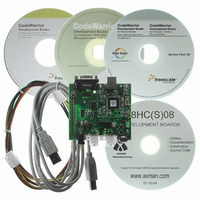DEMO9S08EL32 Freescale Semiconductor, DEMO9S08EL32 Datasheet - Page 101

DEMO9S08EL32
Manufacturer Part Number
DEMO9S08EL32
Description
BOARD DEMO FOR 9S08 EL MCU
Manufacturer
Freescale Semiconductor
Type
MCUr
Datasheets
1.DEMO9S08EL32.pdf
(356 pages)
2.DEMO9S08EL32.pdf
(14 pages)
3.DEMO9S08EL32.pdf
(2 pages)
Specifications of DEMO9S08EL32
Contents
Evaluation Board
Processor To Be Evaluated
MC9S08EL32
Data Bus Width
8 bit
Interface Type
RS-232, USB
Operating Supply Voltage
12 V
Silicon Manufacturer
Freescale
Core Architecture
HCS08
Core Sub-architecture
HCS08
Silicon Core Number
MC9S08
Silicon Family Name
S08EL
Rohs Compliant
Yes
For Use With/related Products
MC9S08EL32
Lead Free Status / RoHS Status
Lead free / RoHS Compliant
- Current page: 101 of 356
- Download datasheet (9Mb)
7.3.6.7
This variation of indexed addressing uses the 16-bit value in the stack pointer (SP) plus a 16-bit offset
included in the instruction as the address of the operand needed to complete the instruction.
7.4
The CPU performs a few special operations that are similar to instructions but do not have opcodes like
other CPU instructions. In addition, a few instructions such as STOP and WAIT directly affect other MCU
circuitry. This section provides additional information about these operations.
7.4.1
Reset can be caused by a power-on-reset (POR) event, internal conditions such as the COP (computer
operating properly) watchdog, or by assertion of an external active-low reset pin. When a reset event
occurs, the CPU immediately stops whatever it is doing (the MCU does not wait for an instruction
boundary before responding to a reset event). For a more detailed discussion about how the MCU
recognizes resets and determines the source, refer to the
chapter.
The reset event is considered concluded when the sequence to determine whether the reset came from an
internal source is done and when the reset pin is no longer asserted. At the conclusion of a reset event, the
CPU performs a 6-cycle sequence to fetch the reset vector from 0xFFFE and 0xFFFF and to fill the
instruction queue in preparation for execution of the first program instruction.
7.4.2
When an interrupt is requested, the CPU completes the current instruction before responding to the
interrupt. At this point, the program counter is pointing at the start of the next instruction, which is where
the CPU should return after servicing the interrupt. The CPU responds to an interrupt by performing the
same sequence of operations as for a software interrupt (SWI) instruction, except the address used for the
vector fetch is determined by the highest priority interrupt that is pending when the interrupt sequence
started.
The CPU sequence for an interrupt is:
After the CCR contents are pushed onto the stack, the I bit in the CCR is set to prevent other interrupts
while in the interrupt service routine. Although it is possible to clear the I bit with an instruction in the
Freescale Semiconductor
1. Store the contents of PCL, PCH, X, A, and CCR on the stack, in that order.
2. Set the I bit in the CCR.
3. Fetch the high-order half of the interrupt vector.
4. Fetch the low-order half of the interrupt vector.
5. Delay for one free bus cycle.
6. Fetch three bytes of program information starting at the address indicated by the interrupt vector
to fill the instruction queue in preparation for execution of the first instruction in the interrupt
service routine.
Special Operations
Reset Sequence
Interrupt Sequence
SP-Relative, 16-Bit Offset (SP2)
MC9S08EL32 Series and MC9S08SL16 Series Data Sheet, Rev. 3
Resets, Interrupts, and System Configuration
Chapter 7 Central Processor Unit (S08CPUV3)
101
Related parts for DEMO9S08EL32
Image
Part Number
Description
Manufacturer
Datasheet
Request
R
Part Number:
Description:
Manufacturer:
Freescale Semiconductor, Inc
Datasheet:
Part Number:
Description:
Manufacturer:
Freescale Semiconductor, Inc
Datasheet:
Part Number:
Description:
Manufacturer:
Freescale Semiconductor, Inc
Datasheet:
Part Number:
Description:
Manufacturer:
Freescale Semiconductor, Inc
Datasheet:
Part Number:
Description:
Manufacturer:
Freescale Semiconductor, Inc
Datasheet:
Part Number:
Description:
Manufacturer:
Freescale Semiconductor, Inc
Datasheet:
Part Number:
Description:
Manufacturer:
Freescale Semiconductor, Inc
Datasheet:
Part Number:
Description:
Manufacturer:
Freescale Semiconductor, Inc
Datasheet:
Part Number:
Description:
Manufacturer:
Freescale Semiconductor, Inc
Datasheet:
Part Number:
Description:
Manufacturer:
Freescale Semiconductor, Inc
Datasheet:
Part Number:
Description:
Manufacturer:
Freescale Semiconductor, Inc
Datasheet:
Part Number:
Description:
Manufacturer:
Freescale Semiconductor, Inc
Datasheet:
Part Number:
Description:
Manufacturer:
Freescale Semiconductor, Inc
Datasheet:
Part Number:
Description:
Manufacturer:
Freescale Semiconductor, Inc
Datasheet:
Part Number:
Description:
Manufacturer:
Freescale Semiconductor, Inc
Datasheet:










